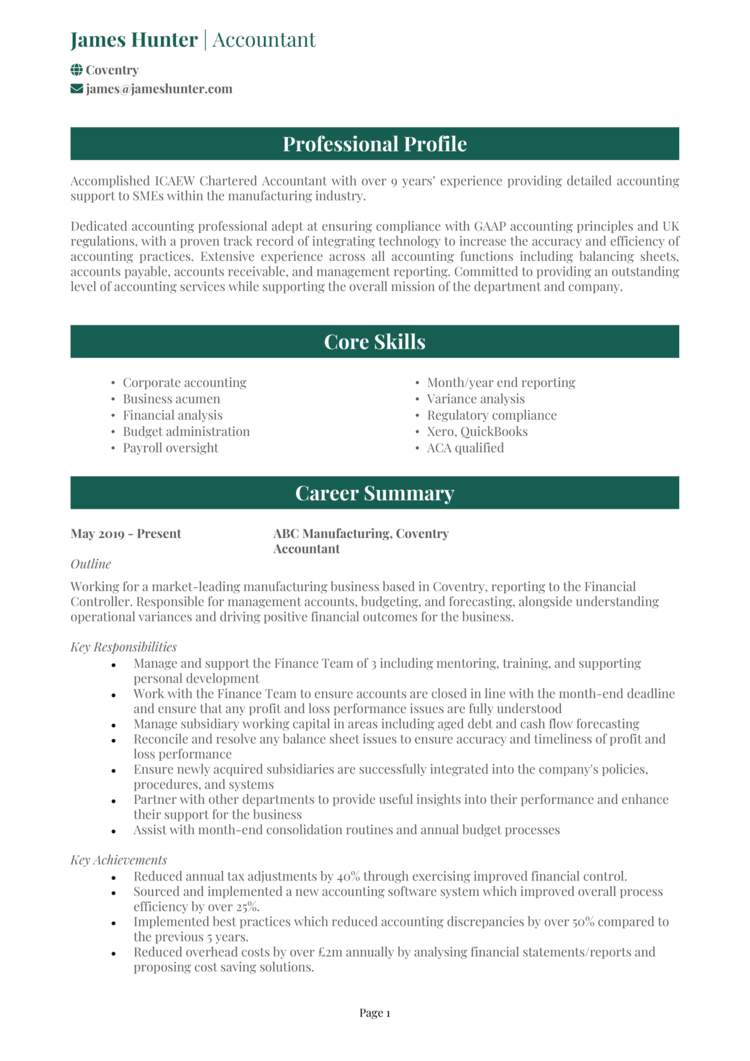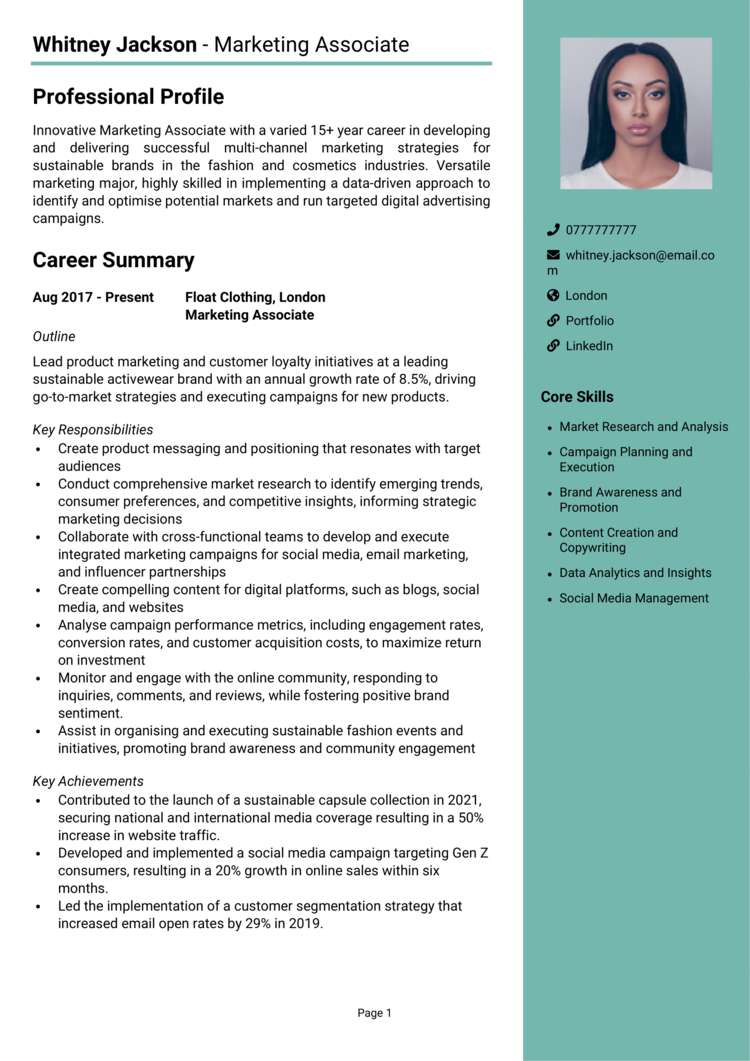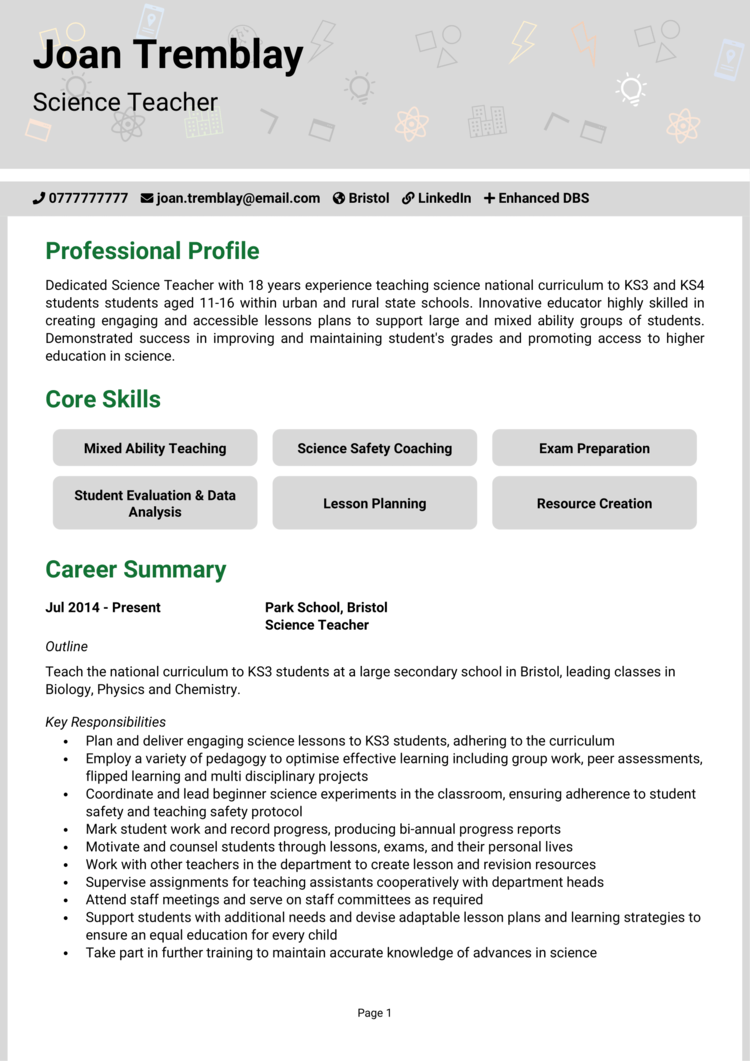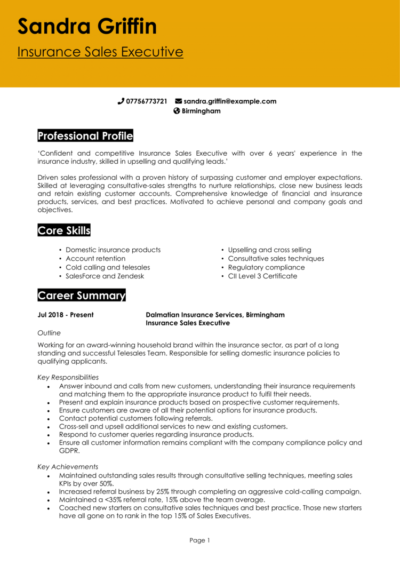Your CV might only be two pages long, but those two pages can make or break your next career move. A good CV isn’t just a summary of your experience – it’s your ticket to landing interviews and opening doors to new opportunities.
This guide, complete with 4 two-page CV examples, will help you craft a CV that gets straight to the point while leaving a lasting impression on recruiters. Let’s make every line count.
2-page CV – Insurance

2-page CV – Accounting

2-page CV – Marketing

2-page CV – Teaching

Should a CV be on two pages?
Two pages is the ideal CV length for most experienced candidates, as it allows ample detail on your skills and past experience, while avoiding the risk of overwhelming or boring busy recruiters. It’s important to be comprehensive yet concise.
How to write your two page CV
Learn how to create your own interview-winning two page CV with this simple step-by-step guide.
A two-page CV is the sweet spot – it’s long enough to showcase your skills and experience but concise enough to hold a recruiter’s attention. Writing a CV is all about finding the balance between detail and focus, showing off your accomplishments without overwhelming or boring busy recruiters.
This guide will walk you through the steps to write a sharp, professional two-page CV that gets you noticed and lands you the interviews you’re after.
How to fit a CV on two pages
If you’ve got plenty of work experience, two pages might not seem like very much at all. If you’re struggling to fit your impressive credentials onto just two pages, then consider the following:
- Adjust the formatting – Make your pages’ margins narrow, and decrease the line spacing to 1.15 or 1.5.
- Keep the CV profile short – Recruiters only need a brief overview of your biggest strengths and value, so save any extra for a cover letter.
- Prioritise core skills – Limit yourself to 8 core skills at most, prioritising the absolute most important and relevant skills for the jobs you’re applying for.
- Trim older experience – If you had a junior position over 10 years ago, it’s fine to cut it out. Old roles only need a brief outline, not a full list of your duties.
- Summarise education – Only show off your highest qualification and most relevant certifications, as those are what recruiters care about most.
How to create a good structure for your two page CV


If you thought your CV was just about its content, then think again: your layout will need to make your past achievements easy for a recruiter to find. With just two pages to work with, a logical CV structure is essential to make the most of the space.
Here’s how to structure your two-page CV:
- Name and contact details – Keep the contact details section simple with just your name, phone number, email, and LinkedIn (if relevant). Avoid adding a full address or a photo of yourself – it takes up unnecessary space.
- Profile – A brief 4-6 line overview of your expertise and career goals. No fluff – get straight to your strengths.
- Core skills – A compact bullet point section highlighting your most relevant skills. Stick to 6-8 points to avoid taking up too much space.
- Work experience – Focus on your last 10 years of employment, listing roles in reverse chronological order. Cut older, less relevant roles or summarise them in a single line.
- Education – List only key qualifications – degrees, diplomas, and certifications. There’s no need to include every training course you’ve ever taken.
- Additional info – If space allows, you can add relevant awards or a short mention of hobbies that reflect job-related skills.
Two page CV format


When space is limited, every inch of your CV needs to work hard. A clean and professional CV format will ensure recruiters can quickly find the information they’re looking for: keep the focus on your value, not your formatting mistakes.
Here’s how to format your two-page CV effectively:
- Bullet points – Keep descriptions concise, limiting them to one or two lines each. Long-winded explanations will eat up space fast.
- Divide sections – Use clear headings and spacing to organise information efficiently while keeping the layout visually appealing.
- Use a clean font – A professional, legible font in an appropriate size (10-13pt) ensures readability without wasting space.
- Keep it the right length – Two pages in length mean no room for fluff. Prioritise what recruiters actually want to see, trimming unnecessary detail; keep any more to a cover letter.
Writing a two page CV profile


Your profile is the opening statement of your CV – a short, punchy introduction that grabs the recruiter’s attention and gets them excited to read more. Since space is limited, get straight to the point – who you are, what you do, and the value you bring.
Newer candidates should consider a personal statement instead, which will also work with a shorter, one-page CV.
Two page CV profile examples
Profile 1
Dedicated Customer Service Representative with three years of experience in handling customer inquiries, resolving complaints, and ensuring a high-quality service experience. Skilled in CRM systems like Salesforce and Zendesk, with a proven ability to manage high call volumes and email correspondence. Strong communication and problem-solving skills, with a commitment to enhancing customer satisfaction and retention.
Profile 2
Reliable Warehouse Operative with over four years of experience in inventory management, stock replenishment, and order fulfilment. Skilled in using warehouse management systems (WMS) and operating forklifts and other heavy machinery. Adept at ensuring efficient stock control and optimising storage solutions to improve workflow efficiency. Committed to maintaining high safety standards and contributing to a productive warehouse environment.
What to include in your Two page CV profile
Here are some tips on what to include in your two-page CV profile:
- Where you’ve worked – Mention industries or companies that are relevant to your target role.
- Your top qualifications – Highlight any degrees, certifications, or training that boost your candidacy.
- Core expertise – Include specific, hard skills that align with the job description.
- Notable achievements – Briefly mention one or two career highlights that prove the impact you make.
- Future goals – Reference ambitions that show alignment with the role or company.
- Value you’ll provide – Recruiters will want to hear why they should hire you – tell them how you’ll positively impact their company.
How to present your core skills section properly


Your core CV skills section gives recruiters a quick snapshot of what you bring to the table. Keep it focused and tailored to the job you’re applying for.
- Stick to 4-8 bullet points – Any more, and you risk wasting space.
- Use short, specific phrases – Avoid vague terms like “strong communicator”; instead, use “client relationship management” or “technical troubleshooting.”
- Tailor it to the job – Highlight skills mentioned in the job advert to maximise relevance.
Work experience


Your work experience section is where you demonstrate how your skills translate into real-world results.
Start with your most recent role and work backwards in reverse chronological order. For each position, include details about the organisation, your role, and the specific contributions you made.
If you’re new to the workforce, focus on internships, part-time roles, or even personal projects that demonstrate transferable skills. If you’ve got very little or no experience, then a one-page CV might be ideal for you.
Formatting your job history for your CV

- Outline – Briefly describe the company, your role, and the type of work you did: give an idea of your place within the organisation.
- Responsibilities – Highlight your core duties, such as leading projects, managing teams, or implementing strategies. Use action verbs in your CV like “developed,” “led,” or “executed.”, sticking to no more than 8 points for your most significant roles.
- Achievements – Show measurable results wherever possible, like increasing sales, improving efficiency, or saving costs. Numbers and percentages work wonders here.
Example job entries for a two page CV
Customer Service Rep | Brightworks Services
Outline
Provided frontline customer service for a telecommunications company, assisting customers with account management, billing inquiries, and technical troubleshooting.
Responsibilities
- Handled inbound and outbound customer calls, resolving queries efficiently.
- Processed customer payments, refunds, and contract modifications using CRM software.
- Investigated and resolved customer complaints, ensuring a positive resolution.
- Provided technical support for broadband and mobile services, troubleshooting common issues.
- Collaborated with internal teams to escalate and resolve complex service issues.
Achievements
- Achieved a 95 percent customer satisfaction rating based on post-call surveys.
- Reduced average call resolution time by 20 percent by streamlining troubleshooting procedures.
- Awarded Employee of the Month for exceptional service and problem-solving skills.
Warehouse Operative | LogiFast Solutions Ltd
Outline
Managed warehouse operations, ensuring efficient handling of stock, order fulfilment, and workplace safety compliance.
Responsibilities
- Received, inspected, and stored incoming stock in designated warehouse locations.
- Picked, packed, and processed customer orders, ensuring accuracy and timely dispatch.
- Operated forklifts and pallet trucks to transport goods within the warehouse safely.
- Updated inventory records using warehouse management software (WMS).
- Followed health and safety regulations to prevent accidents and maintain workplace standards.
Achievements
- Improved picking accuracy by 30 percent by implementing a new scanning system.
- Increased stock replenishment efficiency by 25 percent through optimised workflow planning.
- Maintained a 100 percent safety record over a one-year period with no workplace incidents.
Education section


The education section is important but shouldn’t take up too much space on a two-page CV. Include your most relevant academic achievements, certifications, and training.
For recent graduates, focus on coursework, projects, or internships that demonstrate your skills and knowledge. List your qualifications in reverse chronological order, starting with the most recent.
A one-page CV will likely have a larger education section – consider this if you’re lacking work experience.
To keep this section streamlined:
- Keep it brief – If you have a degree, you don’t need to list your GCSEs.
- Only include relevant training – Certifications and courses that enhance your suitability for the role – nothing old or irrelevant.
- Skip dates for older entries – It doesn’t really matter if you did your A-Levels 8 years ago or 11 years ago – you can cut out the dates if they’re pushing you into a third page!





